Toshiba Portege R700: A Truly Ultraportable 13.3"
by Vivek Gowri on September 7, 2010 6:01 PM EST- Posted in
- Laptops
- SSDs
- Toshiba
- Portege R700
Toshiba Portege R700—Performance
In all seriousness, the first step with this computer should be to do a clean install of Windows. With most other computers, it’s fairly easy to just remove the few pieces of pre-installed crapware--the Nortons and McAfees of the world. But with Toshiba, there’s about 25 mostly useless utilities that don’t need to be there. Online backup, a bunch of media apps, updater services, etc.
One of the few utilities that was quite useful was the function key mapping app. Once you press the Fn key, it brings up a listing of what the function key triggers are, so it’s easy to find. For someone who switches from notebook to notebook on a day to day basis, that was a godsend—you don’t need to hunt for each different F-key to change the brightness or volume.
Now, with that out of the way, we can get to the important stuff—benchmarks! With the SSD and the Core i7, we expected the R700 to fly, and that it most certainly did. The CPU benchmarks were on par with the HP 8440w workstation that we had in for review last month (which uses the same Core i7-620M processor). For a thin and light, especially one under 3.5lbs, our R700 test unit is powerful, easily one of the fastest of the breed. The lesser models with the Core i3 processor will probably perform similarly to the ASUS U33Jc except without quite as much gaming prowess. For the $799 R705, that’s pretty respectable given the aluminum construction and super-light form factor.
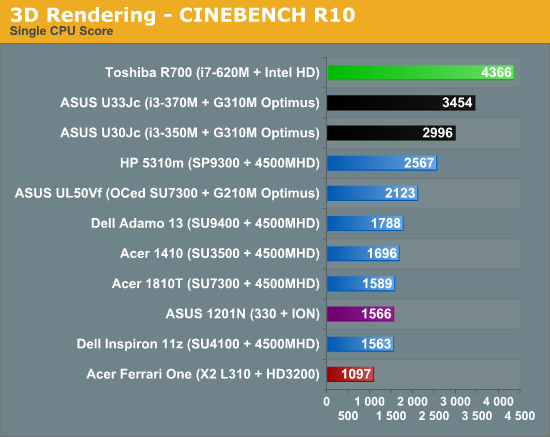
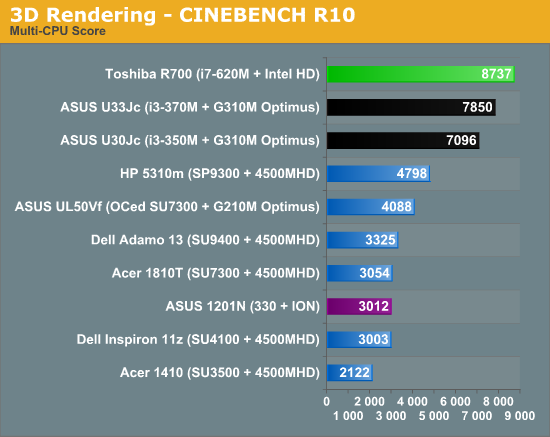
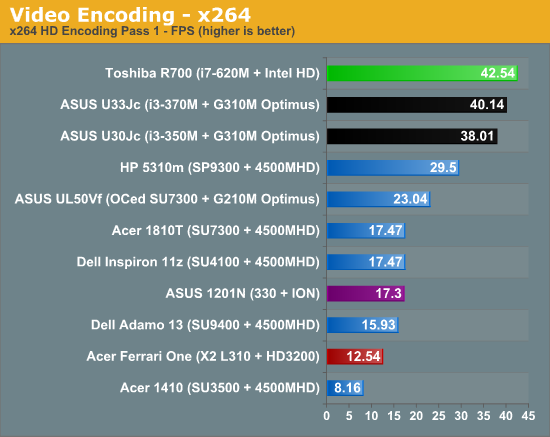
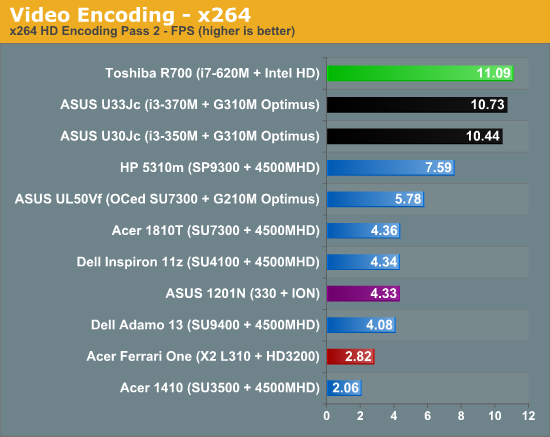
As a sidenote here, I must add that Peacekeeper results couldn’t be taken, due to a bug with the Toshiba fingerprint reader authentication utility that causes Firefox to crash. Did I mention that you should clean install before doing anything else? I’m personally not a huge fan of fingerprint readers in general, so I’d gladly sacrifice the scanner to use Firefox. Though if you’re a Chrome or Opera fan (or an IE fan, if such a creature exists) I suppose this doesn’t really matter.
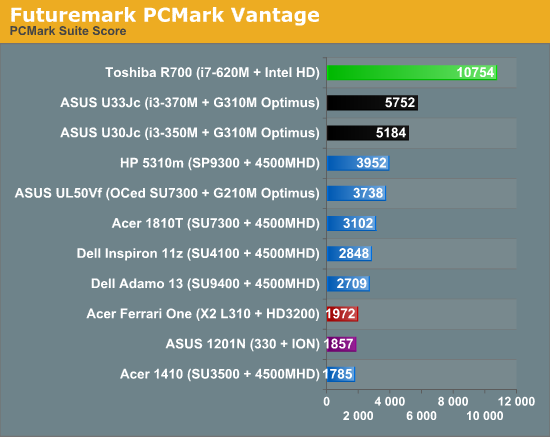
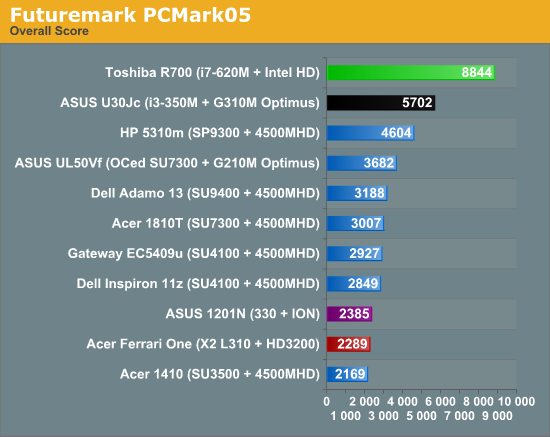
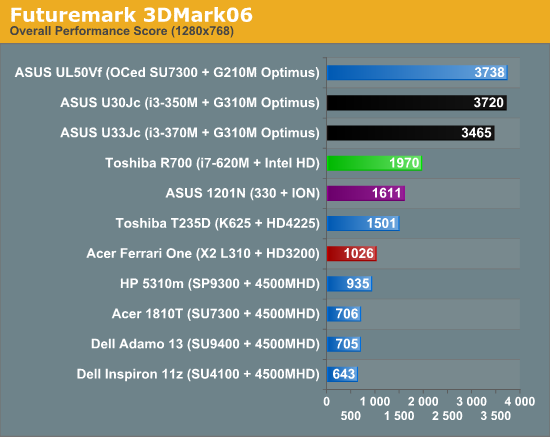
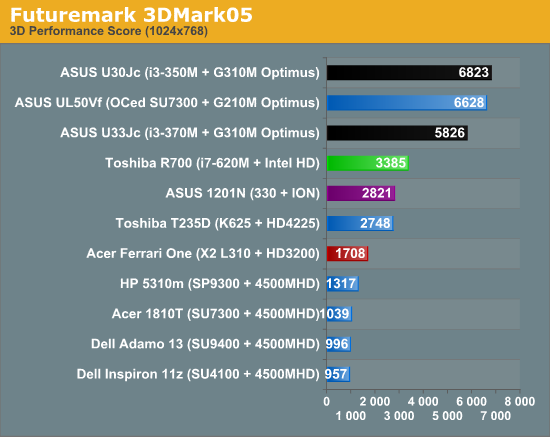
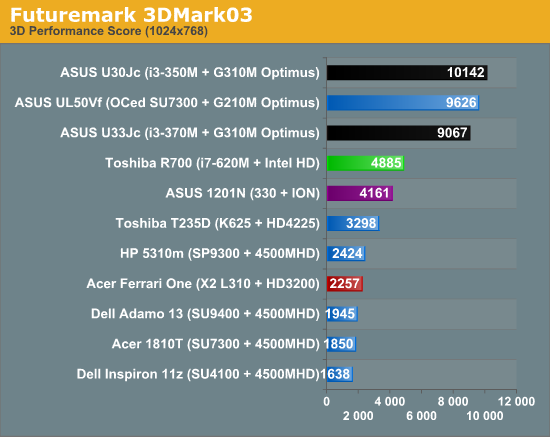
For the guys that like looking at Futuremark results, here you go. The Intel HD graphics chip actually holds its own fairly well against most of the other IGPs out there, at least in 3DMark. The PCMark results are dramatically increased with the SSD, and in some sense are artificially boosted by the number of hard drive access tests in the benchmark. Oddly enough, the SSD doesn’t seem too much faster in daily use other than in application launching. Maybe because the Toshiba SSD in the R700 isn’t as quick as the Intel X18M I had in the Adamo, but it just doesn’t feel as zippy as other SSD-based systems do. Or maybe that’s just Toshiba’s battalion of utilities making themselves felt in full force. Really, it needs a clean install to bring out the best performance, I can’t emphasize that enough.










43 Comments
View All Comments
FH123 - Wednesday, September 8, 2010 - link
So, let me get this straight. The specs look great, but then again those facts are easily accessible and the resulting perfomance can almost be guessed. As you say in the last sentence of the introduction, would it hold up to physical inspection, that's what we read the article for. The article does not disappoint and shows beautifully how a product that looks good on paper can be ... a piece of crap. Bad, mushy keyboard, bad screen, flimsy build quality. So the conclusion is: A great notebook ... with a myriad of flaws? I don't think so. How about a terrible notebook with good perfomance at a good price! Why does the specification / performance outweigh the human-interface factors? Don't get me wrong. The article as a whole plainly spells out what's wrong with today's laptop market and that's great. I love it. Keep doing it, please. Cause what's wrong is, everyone is buying their equipment online and specs have become everything. Certain specs that is. That's why honest hands-on reports are so important. High brightness, high resolution displays, but contrast, black-level and everything else be damned, right? The marketing department hasn't copped on yet. Low weight? Sure, easy to market. Mushy, pancake like consistency of the laptop? How do you quantify that? Ah sure, it must not be important then. Keyboards? Don't get me started.VivekGowri - Wednesday, September 8, 2010 - link
At $799 or $829 (whatever the R705 goes for), those flaws are excusable given the performance, battery life, long list of features, the overall aesthetic, magnesium casing, and superlight travel weight. Every $800 notebook has a crap screen. Bar none. Many of them have mediocre keyboards, and most have some questionable bits of plastic brightwork. At $799, I'd gladly excuse those flaws and get one. It's a budget ultraportable, and it might have a few rough edges. Most of them you can get used to, especially since everything else in the same market sector has a similar set of flaws, sometimes even more critical ones.However, at $1599, well within range of VAIO Z pricing, these flaws are almost inexcusable. Nobody want's a $1600 computer with keyboard flex, a not so great screen, etc. It's just bad. The VAIO Z costs maybe 10% more, has a far better GPU, nearly as powerful CPU, weighs the same, has a screen that's maybe a thousand times better, a better keyboard, better styling and better build quality. It's like the holy grail of thin and lights. So once you get in that pricing ball park, you damn well better have a really impressive computer, and what's impressive at $799 most certainly will not fly at $1599.
FH123 - Wednesday, September 8, 2010 - link
OK, point taken. The machine I'm actually angry about is my own, a Thinkpad T410s. A premium machine with a good keyboard and solid build-quality, but an abysmal screen. Black-level 2.9 cd/m2, contrast 95:1 according to notebookcheck.net, and it shows. Also my boss has a Sony Z series and it seems flimsy to me, compared to the heavier Thinkpad.Pjotr - Wednesday, September 8, 2010 - link
I've had the Acer 3820TG 13.3" since this spring and I love it for the obvious benefits: 1.7 kg weight, 8 hour battery life (spec), Core i5-450, 2.4 GHz, 4 GB RAM, Inte/ATI 5650 1 GB auto-switchable graphics (battery vs external power)The screen is horrible compared to the IPSes I'm used to on my home and work desktops. But this is just an increadible package at the price it sells for, just over half of that Toshiba, which doesn't have the 3D graphics to compare.
Now where's the review? :-)
TejTrescent - Wednesday, September 8, 2010 - link
As an owner of a 3810T 13.3", I have to agree.Acer's little ultraportables are amazing--I kinda wish I'd waited for the 3820's, but I picked this laptop up for 500$ and it turns heads all the time about how small it is and the frequent real world 8+ hours on my battery (light browsing, IMs, etc.. only get about 5 under Ubuntu, 10+ under Win7 usually).
I'd like to see a good 3820 review though to see if I should try to justify the upgrade.
hdjii - Wednesday, September 8, 2010 - link
I know that screen replacement is not trivial, but can a good quality LCD screen be found which would fit this laptop?Is a DIY screen upgrade feasible for any of the otherwise excellent laptops you have reviewed?
Howard
Guspaz - Wednesday, September 8, 2010 - link
I find your battery life results questionable. I have the r700-1320 (same as reviewed except for a 320GB 7200RPM HDD and an i5-520) While I haven't done any idle benchmarks, battery life with even light web surfing (and a fresh Win7 install) is closer to 4 hours (sometimes less) than 5.5. To claim that the laptop will get 5.5 to 6 hours is misleading; I've never seen battery life that long on the r700, and posters on notebookerview seem to back me up.One other thing worth mentioning is that the stock bloatware-infested install of Windows locks up frequently; this is actually what forced me to do a clean install. After doing a clean install, the situation is much improved in that regard, although I've noticed some other irregularities.
JarredWalton - Wednesday, September 8, 2010 - link
We test with battery optimized settings on all laptops, with no Firewall/AV software, and we disable the other utilities. LCD is calibrated for ~100nits (as close as possible), we run the Power Saver profile, HDD is set to go to sleep after 1 minute of idle, system never powers off or sleeps, no display dimming or powering off, WiFi set to maximum power savings, min CPU 0/max CPU 50, hybrid sleep and USB sleep enabled. I think that covers everything.In my experience, the "Balanced" power profile can cut off anywhere from 10 to 20% of the battery life, depending on the laptop and manufacturer.
Note that a clean install of Windows may not always get you the "optimal" results -- there are frequently power saving features or utilities that you need to install. As an example, Toshiba has a DVD power off utility that we used. Also, the Internet tests are highly variable if you're not using the same pages as we are, but given we got four hours of x264 playback I'd say that's a good minimum baseline.
Guspaz - Thursday, September 9, 2010 - link
Thanks for your reply. I think I've got similar settings to what you guys test with (including the toshiba DVD power tool), except for the 50% CPU limit and the lack any AV software. I wouldn't be surprised if MSE were knocking off a chunk of battery life, but I'm not willing to sacrifice that protection for some extra battery life :)Belard - Wednesday, September 8, 2010 - link
Recently, I had some time to kill and checked out Best Buy... man, every single notebook computer came with these horrible chick-let keyboards. Like from the old IBM PC Jr. Days! They sucked then and still mostly suck now.Anandtech did a recent review of Thinkpad's X100e with perhaps the best chicklet keyboard on the market.
Well, for folks looking for a notebook with a NORMAL Keyboard and matte screen, Lenovo's standard ThinkPad line has them. And guess what else they do.... THEY DON'T LOAD UP THINKPADS with BLOAT-WARE! No Norton or Mcafee. Yes, a few of their own tools (nice ones too, love their wireless manager), thats it.
$900~1800 for the Toshiba? Blah.
At about $1500, the ThinkPad T410s is almost an Ultra-portable. Its 14", had an internal optical drive as well as optional WAN (at&t or Verizon or Clear), 3.9lbs... and it has a good keyboard and standard features that'll smoke the Toshiba. The screen isn't as bright, but I'll take a good matte screen any day over any glossy notebook. And if people check out eCoupons, they can usually save $150~300 if the timing is right ;) The latest ThinkPad keyboards (not the x100 or Edge) have spill-channels to protect the computer with perhaps the BEST layout and feel over ANY notebook. Only thing that sucks, the @#(*^$@ Control / Fn keys are backwards (Use BIOS option to flip).
But with my personal experience, I'd prefer a normal T410 over the S model. The S is barely over an inch thick vs. 1.5" on a non S-model. There the NON-S models are more sturdy, more ports, easier to work on and upgrade (2.5" drive vs 1.8")... and I'd rather pocket the $500 difference.
Tip: the $600 L (or older SL) models are decent, but may or may-not be matte. Keyboards are very good (feel wise) but not the great layouts like in the T/W series. L's are not as tough as Ts.